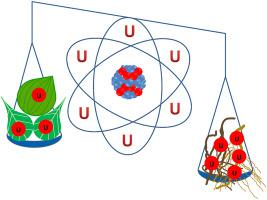Journal of Environmental Radioactivity ( IF 2.3 ) Pub Date : 2021-02-05 , DOI: 10.1016/j.jenvrad.2021.106544 Anna Burger , Marieluise Weidinger , Nils Baumann , Andreas Vesely , Irene Lichtscheidl

|
Uranium (U) is a naturally occurring metal; its environmental levels can be increased due to processes in the nuclear industry and fertilizer production. The transfer of U in the food chain from plants is associated with deleterious chemical and radiation effects. To date, limited information is available about U toxicity on plant physiology. This study investigates the responses of metal-accumulating plants to different concentrations of U. The plants Noccaea caerulescens and Noccaea goesingense are known as metal hyperaccumulators and therefore could serve as candidates for the phytoremediation of radioactive hotspots; Plantago major is a widely used pharmaceutical plant that pioneers polluted grounds and therefore should not contain high concentrations of toxic elements. The experimental plants were grown hydroponically at U concentrations between 1 μM and 10 mM.
The content of U and essential elements was analyzed in roots and leaves by ICP-MS. The amount of accumulated U was influenced by its concentration in the hydroponics. Roots contained most of the metal, whereas less was transported up to the leaves, with the exception of N. goesingense in a medium concentration of U. U also influenced the nutrient profile of the plants. We localized the U in plant tissues using EDX in the SEM. U was evenly distributed in roots and leaves of Noccaea species, with one exception in the roots of N. goesingense, where the central cylinder contained more U than the cortex.
The toxicity of U was assessed by measuring growth and photosynthetic parameters. While root biomass of N. caerulescens was not affected by U, root biomass of N. goesingense decreased significantly at high U concentrations of 0.1 and 10 mM and root biomass of P. major decreased at 10 mM U. Dry weight of leaves was decreased at different U concentrations in the three plant species; a promotive effect was observed in N. caerulescens at lowest concentration offered. Chlorophyll a fluorescence was not affected or negatively affected by U in both Noccaea species, whereas in Plantago also positive effects were observed.
Our results show that the impact of U on Plantago and Noccaea relates to its external concentration and to the plant species. When growing in contaminated areas, P. major should not be used for medicinal purpose. Noccaea species and P. major could immobilize U in their rhizosphere in hotspots contaminated by U, and they could extract limited amounts of U into their leaves.
中文翻译:

蓄积植物Noccaea caerulescens,Noccaea goingense和Plantago major对铀的反应
铀(U)是天然金属;由于核工业和化肥的生产过程,其环境水平可以提高。U在食物链中从植物的转移与有害的化学和辐射作用有关。迄今为止,关于U对植物生理的毒性的信息很少。这项研究调查了金属富集植物对不同浓度的U的响应。该植物夜蛾(Noccaea caerulescens)和夜蛾(Noccaea goingense)被称为金属超蓄积剂,因此可以作为放射性热点植物修复的候选者。车前草专业是广泛使用的制药厂,率先污染了土壤,因此不应含有高浓度的有毒元素。实验植物以1μM至10 mM的U浓度水培生长。
通过ICP-MS分析了根和叶中U和必需元素的含量。累积的U的量受其在水培法中的浓度影响。根包含大部分金属,而较少的被运到叶片,中度浓度的U. goingense除外。U也影响植物的营养状况。我们在SEM中使用EDX将U定位在植物组织中。U获得均匀地分布在根和叶Noccaea种,在根部有一个例外N. goesingense,其中中央筒含有较多ü比皮质。
通过测量生长和光合作用参数评估了U的毒性。虽然根生物量N.蓝菜没有受到U,的根生物量N. goesingense在0.1和10mM和的根生物量的高浓度ü降低显著P.主要以10mM U.干重的叶子在下降下降三种植物中不同的铀浓度;在所提供的最低浓度的芥蓝猪笼草中观察到了促进作用。叶绿素一个荧光没有影响或负被U在两个影响Noccaea物种,而在车前子也观察到积极的效果。
我们的结果表明,U对车前草和夜蛾的影响与其外部浓度和植物种类有关。在受污染的地区生长时,不应将P. major用作药物。Noccaea物种和P. major可以将U固定在被U污染的热点的根际中,并且可以从叶片中提取有限量的U。



























 京公网安备 11010802027423号
京公网安备 11010802027423号